Geochronological Constraints on the Origin of the Paleoproterozoic Qianlishan Gneiss Domes in the Khondalite Belt of the North China Craton and Their Tectonic implications
Abstract
:1. Introduction
2. Geological Setting
3. Samples and Methods
4. Results
4.1. Field Structural Observations
4.2. Zircon U–Pb Geochronology
4.2.1. S1-Foliated Granitoid Plutons
- (1)
- Sample QL03
- (2)
- Sample QL05
- (3)
- Sample QL19
- (4)
- Sample QL20
4.2.2. F2-Folded Leucocratic Dyke
4.2.3. F2-Cutting Undeformed Pegmatite Dyke
5. Discussions
5.1. Significance of Zircon U–Pb Ages
5.2. Structural Evolution of the Qianlishan Gneiss Domes
5.3. Tectonic Implications
6. Concluding Remarks
Supplementary Materials
Author Contributions
Funding
Data Availability Statement
Conflicts of Interest
References
- Eskola, P.E. The problem of mantled gneiss domes. Q. J. Geol. Soc. 1948, 104, 461–476. [Google Scholar] [CrossRef]
- Hobbs, B.E.; Means, W.D.; Williams, P.F. An outline of Structural Geology; Wiley: New York, NY, USA, 1976; pp. 428–430. [Google Scholar]
- Whitney, D.L.; Teyssier, C.; Vanderhaeghe, O. Gneiss domes and crustal flow. In Gneiss Domes in Orogeny; Whitney, D.L., Teyssier, C., Siddoway, C.S., Eds.; Geological Society of America: Boulder, CO, USA, 2004; Volume 380, pp. 15–34. [Google Scholar]
- Yin, A. Gneiss domes and gneiss dome systems. In Gneiss Domes in Orogeny; Whitney, D.L., Teyssier, C., Siddoway, C.S., Eds.; Geological Society of America Special Paper; Geological Society of America: Boulder, CO, USA, 2004; Volume 380, pp. 1–14. [Google Scholar]
- Xu, Z.Q.; Li, Y.; Ji, S.C.; Li, G.W.; Pei, X.Z.; Ma, X.X.; Xiang, H.; Wang, R.R. Qinling gneiss domes and implications for tectonic evolution of the Early Paleozoic Orogen in Central China. J. Asian Earth Sci. 2020, 188, 104052. [Google Scholar] [CrossRef]
- Brun, J.P. The cluster-ridge pattern of mantled gneiss domes in eastern Finland: Evidence for large-scale gravitational instability of the Proterozoic crust. Earth Planet. Sci. Lett. 1980, 47, 441–449. [Google Scholar] [CrossRef]
- Yin, A. Mechanisms for the formation of domal and basinal detachment faults: A three-dimensional analysis. J. Geophys. Res. Solid Earth 1991, 96, 14577–14594. [Google Scholar] [CrossRef]
- Fletcher, R.C. Three-dimensional folding and necking of a power-law layer: Are folds cylindrical, and, if so, do we understand why? Tectonophysics 1995, 247, 65–83. [Google Scholar] [CrossRef]
- Bell, T.H.; Ham, A.P.; Hayward, N.; Hickey, K.A. On the development of gneiss domes. Aust. J. Earth Sci. 2005, 52, 183–204. [Google Scholar] [CrossRef]
- Lee, J.; Hacker, B.; Wang, Y. Evolution of North Himalayan gneiss domes: Structural and metamorphic studies in Mabja Dome, southern Tibet. J. Struct. Geol. 2004, 26, 2297–2316. [Google Scholar] [CrossRef]
- Zhang, B.; Chai, Z.; Yin, C.Y.; Huang, W.T.; Wang, Y.; Zhang, J.J.; Wang, X.X.; Cao, K. Intra-continental transpression and gneiss doming in an obliquely convergent regime in SE Asia. J. Struct. Geol. 2017, 97, 48–70. [Google Scholar] [CrossRef]
- Zhao, G.C.; Sun, M.; Wilde, S.A.; Li, S.Z. Late Archean to Paleoproterozoic evolution of the North China Craton: Key issues revisited. Precambrian Res. 2005, 136, 177–202. [Google Scholar] [CrossRef]
- Zhao, G.C.; Cawood, P.A.; Li, S.Z.; Wilde, S.A.; Sun, M.; Zhang, J.; He, Y.H.; Yin, C.Q. Amalgamation of the North China Craton: Key issues and discussion. Precambrian Res. 2012, 222, 55–76. [Google Scholar] [CrossRef]
- Yin, C.Q.; Zhao, G.C.; Sun, M.; Xia, X.P.; Wei, C.J.; Zhou, X.W.; Leung, W.H. LA-ICP-MS U–Pb zircon ages of the Qianlishan Complex: Constrains on the evolution of the Khondalite Belt in the Western Block of the North China Craton. Precambrian Res. 2009, 174, 78–94. [Google Scholar] [CrossRef]
- Yin, C.Q.; Zhao, G.C.; Wei, C.J.; Sun, M.; Guo, J.H.; Zhou, X.W. Metamorphism and partial melting of high-pressure pelitic granulites from the Qianlishan Complex: Constraints on the tectonic evolution of the Khondalite Belt in the North China Craton. Precambrian Res. 2014, 242, 172–186. [Google Scholar] [CrossRef]
- Qiao, H.Z.; Yin, C.Q.; Li, Q.L.; He, X.L.; Qian, J.H.; Li, W.J. Application of the revised Ti-in-zircon thermometer and SIMS zircon U–Pb dating of high-pressure pelitic granulites from the Qianlishan-Helanshan Complex of the Khondalite Belt, North China Craton. Precambrian Res. 2016, 276, 1–13. [Google Scholar] [CrossRef]
- Wu, S.J.; Yin, C.Q.; Davis, D.W.; Zhang, J.; Qian, J.H.; Qiao, H.Z.; Xia, Y.F.; Liu, J.N. Metamorphic evolution of high-pressure felsic and pelitic granulites from the Qianlishan Complex and tectonic implications for the Khondalite Belt, North China Craton. Geol. Soc. Am. Bull. 2020, 132, 2253–2266. [Google Scholar] [CrossRef]
- Lu, L.Z.; Xu, X.C.; Liu, F.L. Early Precambrian Khondalites in North China; Changchun Publishing House: Changchun, China, 1996; pp. 1–277. (In Chinese) [Google Scholar]
- Qiao, H.Z. Structural and Geochronological Studies of the Qianlishan-Helanshan Complex in North China. Ph.D. Dissertation, Sun Yat-sen University, Guangzhou, China, 2019; pp. 1–163, (In Chinese with English Abstract). [Google Scholar]
- Yin, C.Q.; Qiao, H.Z.; Lin, S.F.; Li, C.C. Zhang, J.; Qian, J.H.; Wu, S.J. Deformation history of the Qianlishan complex, Khondalite belt, North China: Structures, ages and tectonic implications. J. Struct. Geol. 2020, 141, 104176. [Google Scholar] [CrossRef]
- He, X.L.; Yin, C.Q.; Long, X.P.; Qian, J.H.; Wang, L.J.; Qiao, H.Z. Archean to Paleoproterozoic continental crust growth in the Western Block of North China: Constraints from zircon Hf isotopic and whole-rock Nd isotopic data. Precambrian Res. 2017, 303, 105–116. [Google Scholar] [CrossRef]
- Zhai, M.G.; Peng, P. Paleoproterozoic events in North China Craton. Acta Petrol. Sin. 2007, 23, 2665–2682, (In Chinese with English Abstract). [Google Scholar]
- Zhai, M.G.; Santosh, M. The early Precambrian odyssey of the North China Craton: A synoptic overview. Gondwana Res. 2011, 20, 6–25. [Google Scholar] [CrossRef]
- Kusky, T.M.; Polat, A.; Windley, B.F.; Burke, K.C.; Dewey, J.F.; Kidd, W.S.F.; Maruyama, S.; Wang, J.P.; Deng, H.; Wang, Z.S.; et al. Insights into the tectonic evolution of the North China Craton through comparative tectonic analysis: A record of outward growth of Precambrian continents. Earth-Sci. Rev. 2016, 162, 387–432. [Google Scholar] [CrossRef]
- Wei, C.; Zhai, M.; Wang, B. Four phases of Orosirian metamorphism in the north North China Craton (NNCC): Insights into the regional tectonic framework and evolution. Earth-Sci. Rev. 2023, 241, 104449. [Google Scholar] [CrossRef]
- Wan, Y.S.; Liu, D.Y.; Xu, Z.Y.; Dong, C.Y.; Wang, Z.J.; Zhou, H.Y.; Yang, Z.S.; Liu, Z.H.; Wu, J.S. Paleoproterozoic crustally derived carbonate-rich magmatic rocks from the Daqinshan area, North China Craton: Geological, petrographical, geochronological and geochemical (Hf, Nd, O and C) evidence. Am. J. Sci. 2008, 308, 351–378. [Google Scholar] [CrossRef]
- Zhou, X.W.; Geng, Y.S. Metamorphic age of the khondalites in the Helanshan region: Constraints on the evolution of the Western block in the North China Craton. Acta Petrol. Sin. 2009, 25, 1843–1852, (In Chinese with English Abstract). [Google Scholar]
- Guo, J.H.; Peng, P.; Chen, Y.; Jiao, S.J.; Windley, B.F. UHT sapphirine granulite metamorphism at 1.93–1.92 Ga caused by gabbronorite intrusions: Implications for tectonic evolution of the northern margin of the North China Craton. Precambrian Res. 2012, 222, 124–142. [Google Scholar] [CrossRef]
- Qian, X.L.; Cui, W.Y.; Wang, S.Q. Evolution of the Inner Mongolia-eastern Hebei Archean Granulite Belt in the North China Craton. In The Records of Geological Research; Department of Geology, Beijing University Press: Beijing, China, 1985. [Google Scholar]
- Shen, Q.H.; Xu, H.F.; Zhang, Z.Q.; Gao, J.F.; Wu, J.S.; Ji, C.L. Precambrian Granulites in China; Geological Publishing House: Beijing, China, 1992. [Google Scholar]
- Zhai, M. Khondalite revisited-record of special geological processes on Earth. Acta Petrol. Sin. 2022, 96, 2967–2997, (In Chinese with English Abstract). [Google Scholar]
- Condie, K.C.; Boryta, M.D.; Liu, J.Z. The origin of khondalites: Geochemical evidence from the Archean to Early Proterozoic granulite belt in the North China Craton. Precambrian Res. 1992, 59, 207–223. [Google Scholar] [CrossRef]
- Lu, L.Z.; Jin, S.Q. P-T-t paths and tectonic history of an early Precambrian granulite-facies terrane, Jining District, South-East Inner-Mongolia, China. J. Metamorph. Geol. 1993, 11, 483–498. [Google Scholar]
- Wan, Y.S.; Liu, D.Y.; Dong, C.Y.; Xu, Z.Y.; Wang, Z.J.; Wilde, S.A.; Yang, Y.H.; Liu, Z.H.; Zhou, H.Y. The Precambrian Khondalite Belt in the Daqingshan area, North China Craton: Evidence for multiple metamorphic events in the Palaeoproterozoic era. Geol. Soc. Lond. Spec. Publ. 2009, 323, 73–97. [Google Scholar] [CrossRef]
- Dan, W.; Li, X.H.; Guo, J.H.; Liu, Y.; Wang, X.C. Integrated in situ zircon U–Pb age and Hf–O isotopes for the Helanshan khondalites in North China Craton: Juvenile crustal materials deposited in active or passive continental margin? Precambrian Res. 2012, 222, 143–158. [Google Scholar] [CrossRef]
- Wang, L.J.; Guo, J.H.; Yin, C.Q.; Peng, P. Petrogenesis of ca. 1.95 Ga meta-leucogranites from the Jining Complex in the Khondalite Belt, North China Craton: Water-fluxed melting of metasedimentary rocks. Precambrian Res. 2017, 303, 355–371. [Google Scholar] [CrossRef]
- Li, W.X.; Yin, C.Q.; Lin, S.F.; Li, W.J.; Gao, P.; Zhang, J.; Qian, J.H.; Qiao, H.Z. Paleoproterozoic tectonic evolution from subduction to collision of the Khondalite Belt in North China: Evidence from multiple magmatism in the Qianlishan Complex. Precambrian Res. 2022, 368, 106471. [Google Scholar] [CrossRef]
- Yin, C.Q.; Zhao, G.C.; Xiao, W.J.; Lin, S.F.; Gao, R.; Zhang, J.; Qian, J.H.; Gao, P.; Qiao, H.Z.; Li, W.X. Paleoproterozoic accretion and assembly of the Western Block of North China: A new model. Earth-Sci. Rev. 2023, 241, 104448. [Google Scholar] [CrossRef]
- Wan, Y.S.; Song, B.; Liu, D.Y.; Wilde, S.A.; Wu, J.S.; Shi, Y.R.; Yin, X.Y.; Zhou, H.Y. SHRIMP U–Pb zircon geochronology of Palaeoproterozoic metasedimentary rocks in the North China Craton: Evidence for a major Late Palaeoproterozoic tectonothermal event. Precambrian Res. 2006, 149, 249–271. [Google Scholar] [CrossRef]
- Wan, Y.S.; Xu, Z.Y.; Dong, C.Y.; Nutman, A.; Ma, M.Z.; Xie, H.Q.; Liu, S.J.; Liu, D.Y.; Wang, H.C.; Cu, H. Episodic paleoproterozoic (~2.45, ~1.95 and ~1.85 Ga) mafic magmatism and associated high temperature metamorphism in the Daqingshan area, North China Craton: SHRIMP zircon U–Pb dating and whole-rock geochemistry. Precambrian Res. 2013, 224, 71–93. [Google Scholar] [CrossRef]
- Xia, X.P.; Sun, M.; Zhao, G.C.; Luo, Y. LA-ICP-MS U–Pb geochronology of detrital zircons from the Jining Complex, North China Craton and its tectonic significance. Precambrian Res. 2006, 144, 199–212. [Google Scholar] [CrossRef]
- Xia, X.P.; Sun, M.; Zhao, G.C.; Wu, F.Y.; Xu, P.; Zhang, J.H.; Luo, Y. U–Pb and Hf isotopic study of detrital zircons from the Wulashan khondalites: Constraints on the evolution of the Ordos Terrane, Western Block of the North China Craton. Earth Planet. Sci. Lett. 2006, 241, 581–593. [Google Scholar] [CrossRef]
- Xia, X.P.; Sun, M.; Zhao, G.C.; Wu, F.Y.; Xu, P.; Zhang, J.; He, Y.H. Paleoproterozoic crustal growth in the Western Block of the North China Craton: Evidence from detrital zircon Hf and whole rock Sr-Nd isotopic compositions of the Khondalites from the Jining Complex. Am. J. Sci. 2008, 308, 304–327. [Google Scholar] [CrossRef]
- Dong, C.Y.; Liu, D.Y.; Li, J.J.; Wan, Y.S.; Zhou, H.Y.; Li, C.D.; Yang, Y.H.; Xie, L.W. Palaeoproterozoic Khondalite Belt in the western North China Craton: New evidence from SHRIMP dating and Hf isotope composition of zircons from metamorphic rocks in the Bayan Ul-Helan Mountains area. Chin. Sci. Bull. 2007, 52, 2984–2994, (In Chinese with English Abstract). [Google Scholar] [CrossRef]
- Dong, C.Y.; Wan, Y.S.; Xu, Z.Y.; Liu, D.Y.; Yang, Z.S.; Ma, M.Z.; Xie, H.Q. SHRIMP zircon U–Pb dating of late Paleoproterozoic kondalites in the Daqing Mountains area on the North China Craton. Sci. China Earth Sci. 2013, 56, 115–125. [Google Scholar] [CrossRef]
- Yin, C.Q.; Zhao, G.C.; Guo, J.H.; Sun, M.; Xia, X.P.; Zhou, X.W.; Liu, C.H. U–Pb and Hf isotopic study of zircons of the Helanshan Complex: Constrains on the evolution of the Khondalite Belt in the Western Block of the North China Craton. Lithos 2011, 122, 25–38. [Google Scholar] [CrossRef]
- Jiao, S.J.; Guo, J.H.; Harley, S.L.; Peng, P. Geochronology and trace element geochemistry of zircon, monazite and garnet from the garnetite and/or associated other high-grade rocks: Implications for Palaeoproterozoic tectonothermal evolution of the Khondalite Belt, North China Craton. Precambrian Res. 2013, 237, 78–100. [Google Scholar] [CrossRef]
- Liu, P.H.; Liu, F.L.; Liu, C.H.; Liu, J.H.; Wang, F.; Xiao, L.L.; Cai, J.; Shi, J.R. Multiple mafic magmatic and high-grade metamorphic events revealed by zircons from meta-mafic rocks in the Daqingshan–Wulashan Complex of the Khondalite Belt, North China Craton. Precambrian Res. 2014, 246, 334–357. [Google Scholar] [CrossRef]
- Liu, P.H.; Liu, F.L.; Cai, J.; Liu, C.H.; Liu, J.H.; Wang, F.; Xiao, L.L.; Shi, J.R. Spatial distribution, P–T–t paths, and tectonic significance of high-pressure mafic granulites from the Daqingshan–Wulashan Complex in the Khondalite Belt, North China Craton. Precambrian Res. 2017, 303, 687–708. [Google Scholar] [CrossRef]
- Gou, L.L.; Zhang, C.L.; Brown, M.; Piccoli, P.M.; Lin, H.B.; Wei, X.S. P–T–t evolution of pelitic gneiss from the basement underlying the Northwestern Ordos Basin, North China Craton, and the tectonic implications. Precambrian Res. 2016, 276, 67–84. [Google Scholar] [CrossRef]
- Cai, J.; Liu, F.L.; Liu, P.H. Paleoproterozoic multistage metamorphic events in Jining metapelitic rocks from the Khondalite Belt in the North China Craton: Evidence from petrology, phase equilibria modelling and U–Pb geochronology. J. Asian Earth Sci. 2017, 138, 515–534. [Google Scholar] [CrossRef]
- Cai, J.; Liu, F.L.; Liu, P.H.; Wang, F.; Liu, C.H.; Shi, J.R. Anatectic record and P–T path evolution of metapelites from the Wulashan Complex, Khondalite Belt, North China Craton. Precambrian Res. 2017, 303, 10–29. [Google Scholar] [CrossRef]
- Xu, X.F.; Gou, L.L.; Long, X.P.; Dong, Y.P.; Liu, X.M.; Zi, J.W.; Li, Z.H.; Zhang, C.L.; Liu, L.; Zhao, J. Phase equilibrium modelling and SHRIMP zircon U–Pb dating of medium-pressure pelitic granulites in the Helanshan complex of the Khondalite Belt, North China Craton, and their tectonic implications. Precambrian Res. 2018, 314, 62–75. [Google Scholar] [CrossRef]
- Santosh, M.; Tsunogae, T.; Li, J.H.; Liu, S.J. Discovery of sapphirine-bearing Mg–Al granulites in the North China Craton: Implications for Paleoproterozoic ultrahigh temperature metamorphism. Gondwana Res. 2007, 11, 263–285. [Google Scholar] [CrossRef]
- Jiao, S.J.; Fitzsimons, I.C.; Guo, J.H. Paleoproterozoic UHT metamorphism in the Daqingshan Terrane, North China Craton: New constraints from phase equilibria modeling and SIMS U–Pb zircon dating. Precambrian Res. 2017, 303, 208–227. [Google Scholar] [CrossRef]
- Jiao, S.J.; Fitzsimons, I.C.; Zi, J.W.; Evans, N.J.; Mcdonald, B.J.; Guo, J.H. Texturally controlled U–Th–Pb monazite geochronology reveals Paleoproterozoic UHT metamorphic evolution in the Khondalite belt, North China craton. J. Petrol. 2020, 61, egaa023. [Google Scholar] [CrossRef]
- Jiao, S.J.; Evans, N.J.; Guo, J.H.; Fitzsimons, I.C.W.; Zi, J.W.; McDonald, B.J. Establishing the PT path of UHT granulites by geochemically distinguishing peritectic from retrograde garnet. Am. Mineral. 2021, 106, 1640–1653. [Google Scholar] [CrossRef]
- Gou, L.L.; Li, Z.H.; Liu, X.M.; Dong, Y.P.; Zhao, J.; Zhang, C.L.; Liu, L.; Long, X.P. Ultrahigh-temperature metamorphism in the Helanshan complex of the Khondalite Belt, North China Craton: Petrology and phase equilibria of spinel-bearing pelitic granulites. J. Metamorph. Geol. 2018, 36, 1199–1220. [Google Scholar] [CrossRef]
- Gou, L.L.; Zi, J.W.; Dong, Y.P.; Liu, X.M.; Li, Z.H.; Xu, X.F.; Zhang, C.L.; Liu, L.; Long, X.P.; Zhao, Y.H. Timing of two separate granulite-facies metamorphic events in the Helanshan complex, North China Craton: Constraints from monazite and zircon U–Pb dating of pelitic granulites. Lithos 2019, 350, 105216. [Google Scholar] [CrossRef]
- Jiao, S.J.; Guo, J.H. Paleoproterozoic UHT metamorphism with isobaric cooling (IBC) followed by decompression–heating in the Khondalite Belt (North China Craton): New evidence from two sapphirine formation processes. J. Metamorph. Geol. 2020, 38, 357–378. [Google Scholar] [CrossRef]
- Zheng, Y.Y.; Qi, Y.; Zhang, D.; Jiao, S.J.; Huang, G.Y.; Guo, J.H. New insight from the first application of Ti-in-Quartz (TitaniQ) thermometry mapping in the eastern Khondalite Belt, North China Craton. Front. Earth Sci. 2022, 10, 860057. [Google Scholar] [CrossRef]
- Wang, L.J.; Guo, J.H.; Yin, C.Q.; Peng, P.; Zhang, J.; Spencer, C.J.; Qian, J.H. High-temperature S-type granitoids (charnockites) in the Jining complex, North China Craton: Restite entrainment and hybridization with mafic magma. Lithos 2018, 320–321, 435–453. [Google Scholar] [CrossRef]
- Wang, L.J.; Guo, J.H.; Peng, P. Petrogenesis of Paleoproterozoic Liangcheng garnet granitoids in the Khondalite Belt, North China Craton. Acta Petrol. Sin. 2021, 37, 375–390, (In Chinese with English Abstract). [Google Scholar]
- Shi, Q.; Ding, D.; Xu, Z.Y.; Li, W.Q.; Li, G.; Li, C.X.; Zhao, Z.H.; Zhang, G.B.; Jiang, X.Y.; Yang, R.B.; et al. Metamorphic evolution of Daqingshan supracrustal rocks and garnet granite from the North China Craton: Constraints from phase equilibria modelling, geochemistry, and SHRIMP U–Pb geochronology. Gondwana Res. 2021, 97, 101–120. [Google Scholar] [CrossRef]
- Jiang, X.Z.; Yu, S.Y.; Liu, Y.J.; Li, S.Z.; Lv, P.; Peng, Y.B.; Gao, X.Y.; Ji, W.T.; Li, C.Z.; Xie, W.M. Episodic metamorphism and anatexis within the Khondalite Belt, North China Craton: Constraint from Late-Paleoproterozoic fluid-fluxed melting of the Daqingshan Complex. Precambrian Res. 2022, 369, 106504. [Google Scholar] [CrossRef]
- Qiao, H.Z. Detrital zircon U–Pb ages of the Huangqikou Formation of the Changcheng System in the Qianlishan Area, western North China Craton and their geological implications. Acta Geol. Sichuan 2021, 41, 33–39, (In Chinese with English Abstract). [Google Scholar]
- Li, W.J. Geochronology and Geochemistry of the Helanshan-Qianlishan Granites in North China. Master’s Dissertation, Sun Yat-sen University, Guangzhou, China, 2018; pp. 1–103, (In Chinese with English Abstract). [Google Scholar]
- Lu, C.S.; Qian, J.H.; Yin, C.Q.; Gao, P.; Guo, M.J.; Zhang, W.F. Ultrahigh temperature metamorphism recorded in the Lüliang Complex, Trans-North China Orogen: P–T–t evolution and heating mechanism. Precambrian Res. 2022, 383, 106900. [Google Scholar] [CrossRef]
- Wiedenbeck, M.; Allé, P.; Corfu, F.; Griffin, W.L.; Meier, M.; Oberli, F.; Quadt, A.; Roddick, J.C.; Spiegel, W. Three natural zircon standards for U-Th-Pb, Lu-Hf, trace element and REE analyses. Geostand. Newsl. 1995, 19, 1–23. [Google Scholar] [CrossRef]
- Reed, W. Certificate of Analysis: Standard Reference Materials 610 and 611; National Institute of Standards and Technology: Gaithersburg, MD, USA, 1992.
- Sláma, J.; Kosler, J.; Condon, D.; Crowley, J.L.; Gerdes, A.; Hanchar, J.M.; Horstwood, M.S.A.; Morris, G.A.; Nasdala, L.; Norberg, N.; et al. Plešovice zircon–A new natural reference material for U–Pb and Hf isotopic microanalysis. Chem. Geol. 2008, 249, 1–35. [Google Scholar] [CrossRef]
- Liu, Y.S.; Hu, Z.C.; Gao, S.; Günther, D.; Xu, J.; Gao, C.G.; Chen, H.H. In situ analysis of major and trace elements of anhydrous minerals by LA-ICP-MS without applying an internal standard. Chem. Geol. 2008, 257, 34–43. [Google Scholar] [CrossRef]
- Ludwig, K.R. Isoplot/Ex Version 4.15: A Geochronological Toolkit for Microsoft Excel; Berkeley Geochronology Center Special Publication: Berkeley, CA, USA, 2012; Volume 5, p. 75. [Google Scholar]
- Rubatto, D. Zircon trace element geochemistry: Partitioning with garnet and the link between U–Pb ages and metamorphism. Chem. Geol. 2002, 184, 123–138. [Google Scholar] [CrossRef]
- Ramsay, J.G. Folding and Fracturing of Rocks; McGraw-Hill: New York, NY, USA, 1967; p. 568. [Google Scholar]
- Liu, S.J.; Dong, C.Y.; Xu, Z.Y.; Santosh, M.; Ma, M.Z.; Xie, H.Q.; Liu, D.Y.; Wan, Y.S. Palaeoproterozoic episodic magmatism and high-grade metamorphism in the North China Craton: Evidence from SHRIMP zircon dating of magmatic suites in the Daqingshan area. Geol. J. 2013, 48, 429–455. [Google Scholar] [CrossRef]
- Li, W.J.; Yin, C.Q.; Long, X.P.; Zhang, J.; Xia, X.P.; Wang, L.J. Paleoproterozoic S-type granites from the Helanshan Complex in Inner Mongolia: Constraints on the provenance and the Paleoproterozoic evolution of the Khondalite Belt, North China Craton. Precambrian Res. 2017, 299, 195–209. [Google Scholar] [CrossRef]
- Qiao, H.Z.; Yin, C.Q.; Xiao, W.J.; Zhang, J.; Qian, J.H.; Wu, S.J. Paleoproterozoic polyphase deformation in the Helanshan Complex: Structural and geochronological constraints on the tectonic evolution of the Khondalite Belt, North China Craton. Precambrian Res. 2022, 368, 106468. [Google Scholar] [CrossRef]
- Gan, S.F.; Qian, X.L. A plate-tectonic model for the evolution of the Daqingshan granulite belt in Inner Mongolia, China. Acta Geol. Sin. 1996, 70, 298–308, (In Chinese with English Abstract). [Google Scholar]
- Yu, H.F.; Sun, D.Y. Deformational-Metamorphic Evolution of Ductile Shear Zone in Daqingshan Area. J. Chang. Univ. Earth Sci. 1996, 26, 310–315, (In Chinese with English Abstract). [Google Scholar]
- Liu, T.J.; Li, W.M.; Liu, Y.J.; Jin, W.; Shao, Y.L. Rheology of the anatectic mid-lower Crust in the Paleoproterozoic orogenic belt in Daqingshan. Inner Mongolia. Acta Petrol. Sin. 2020, 55, 459–486, (In Chinese with English Abstract). [Google Scholar]
- Liu, T.J.; Li, W.M.; Liu, Y.J.; Jin, W.; Zhao, Y.L.; Iqbal, M.Z. Deformation characteristics of the high-grade metamorphic and anatectic rocks in the Daqingshan Paleoproterozoic orogenic belt, Inner Mongolia: A case study from the Shijiaqu-Xuehaigou area. Precambrian Res. 2022, 374, 106644. [Google Scholar] [CrossRef]
- Xu, Z.Y.; Liu, Z.H.; Yang, Z.S. Structures of early metamorphic strata in the khondalite series in the Daqingshan-Wulashan area, Inner Mongolia: Results of the sub-horizontal bedding-parallel detachment deformation in the lower crust. J. Stratigr. 2005, 29, 423–432, (In Chinese with English Abstract). [Google Scholar]
- Xu, Z.Y.; Liu, Z.H.; Yang, Z.S.; Wu, X.W.; Chen, X.F. Structure of metamorphic strata of the khondalite series in the Daqingshan-Wulashan area, central Inner Mongolia, China, and their geodynamic implications. Geol. Bull. China 2007, 26, 526–536, (In Chinese with English Abstract). [Google Scholar]
- Liu, Z.H.; Pan, B.W.; Li, P.C.; Zhu, K.; Dong, X. Ductile Shear Zone in High-Grade Metamorphic Rocks and Its Rheomorphic Mechanism in the Daqing Mountain Area, Inner Mongolia. Earth Sci. 2017, 42, 2105–2116, (In Chinese with English Abstract). [Google Scholar]
- Qiao, H.Z.; Yin, C.Q.; Zhang, J.; Qian, J.H.; Wu, S.J. New Discovery of ~1866 Ma high-temperature mylonite in the Helanshan Complex: Marking a late-stage ductile shearing in the Khondalite Belt, North China Craton. Acta Geol. Sin. (Engl. Ed.) 2021, 95, 1418–1419. [Google Scholar] [CrossRef]
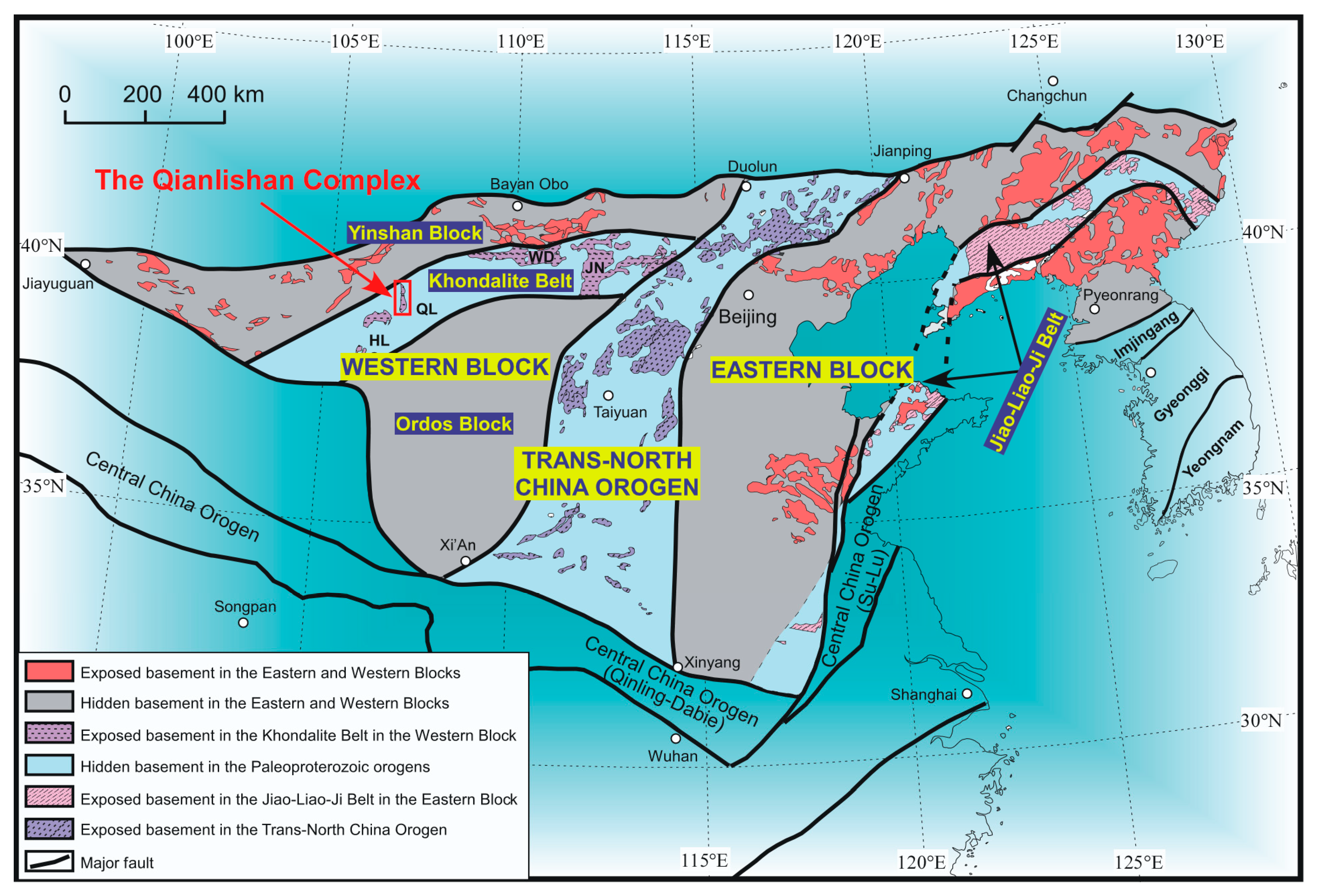
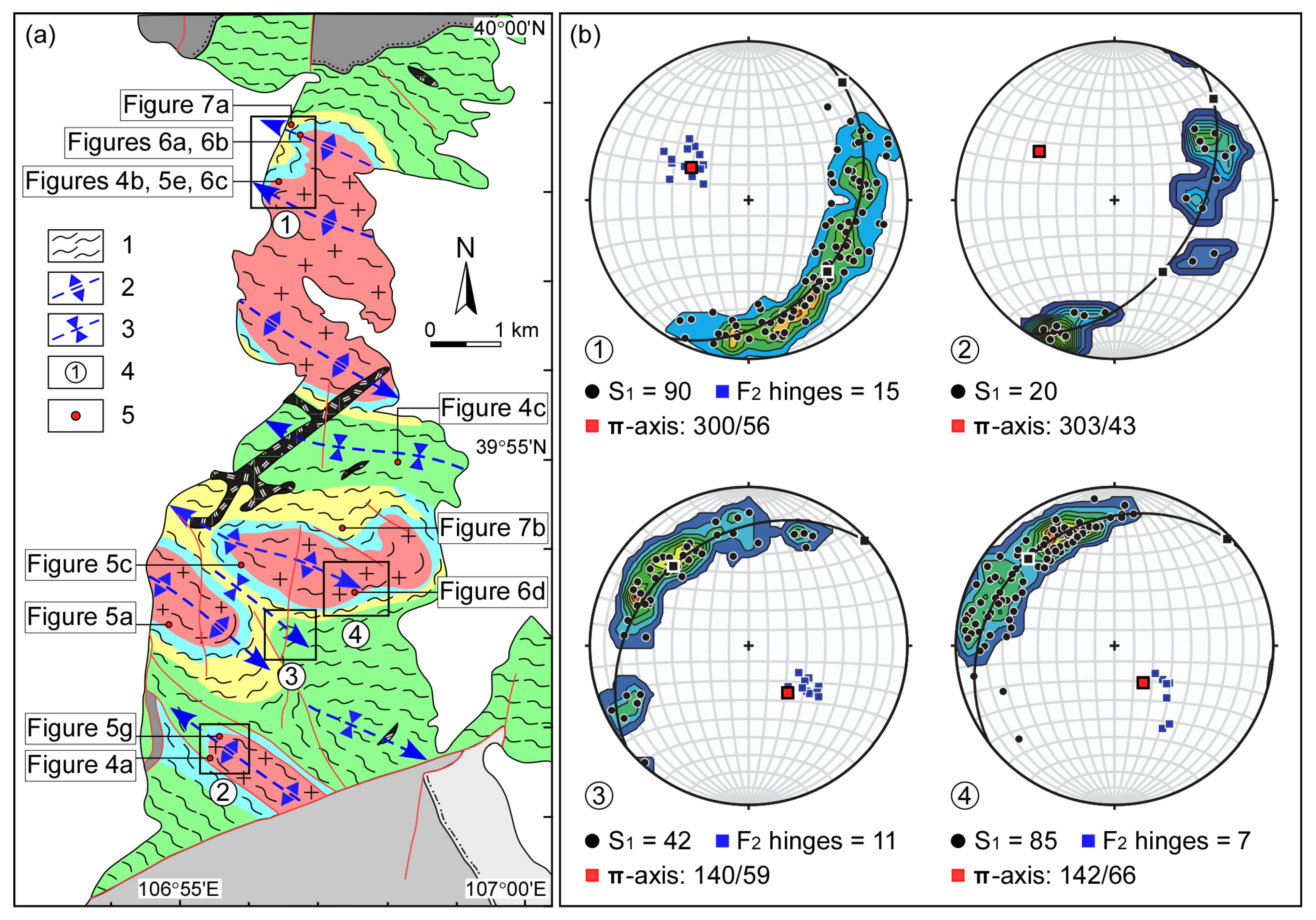
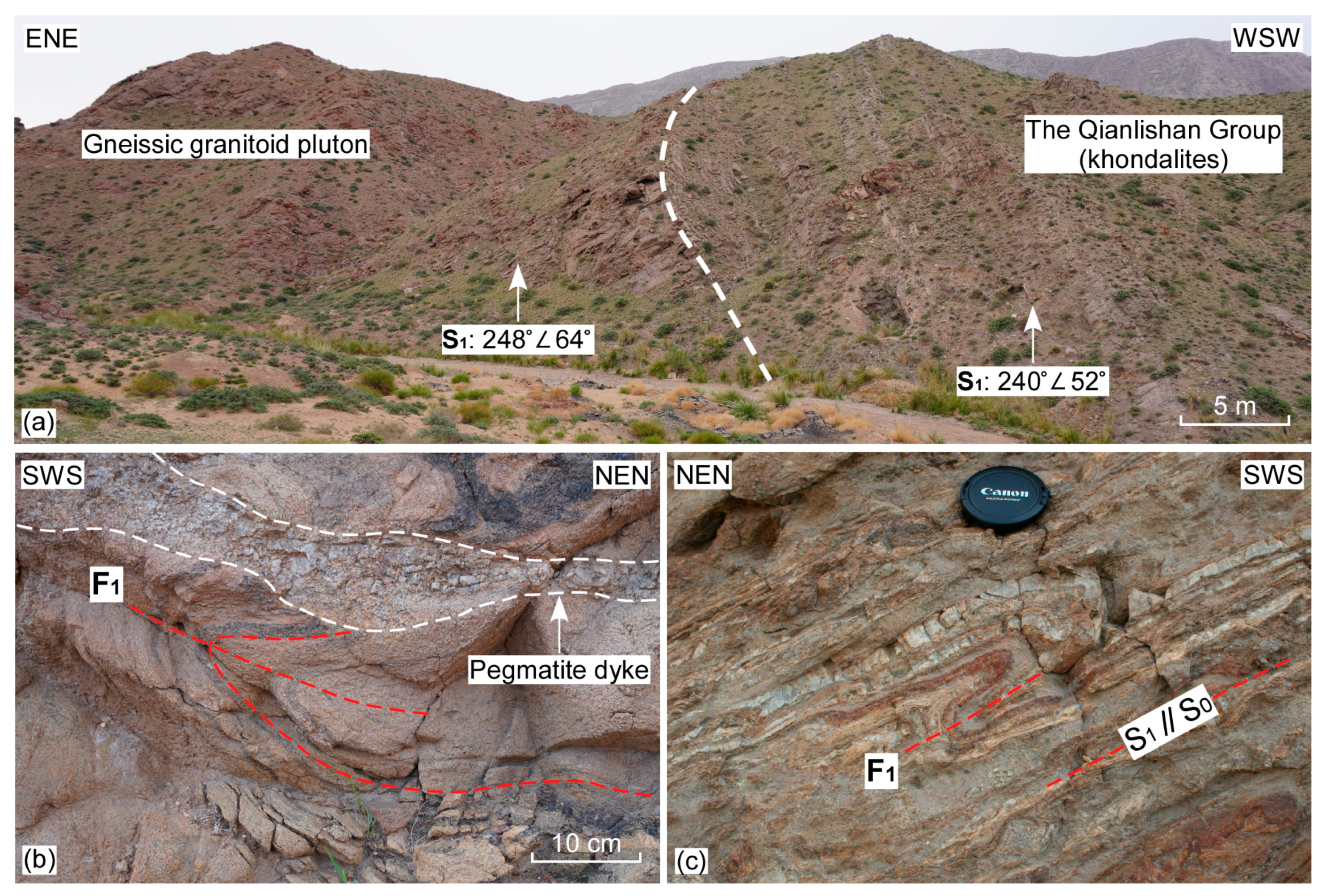
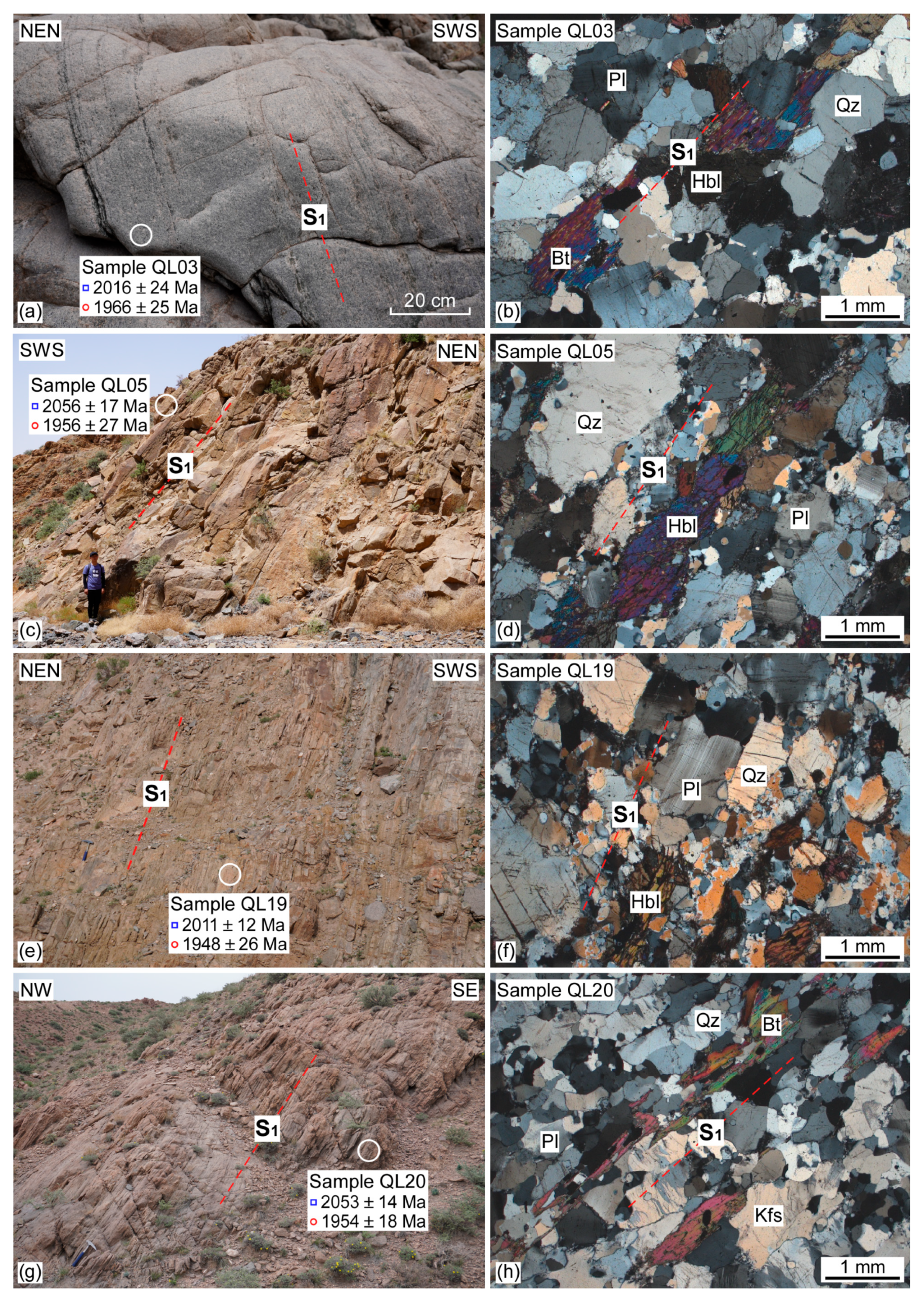

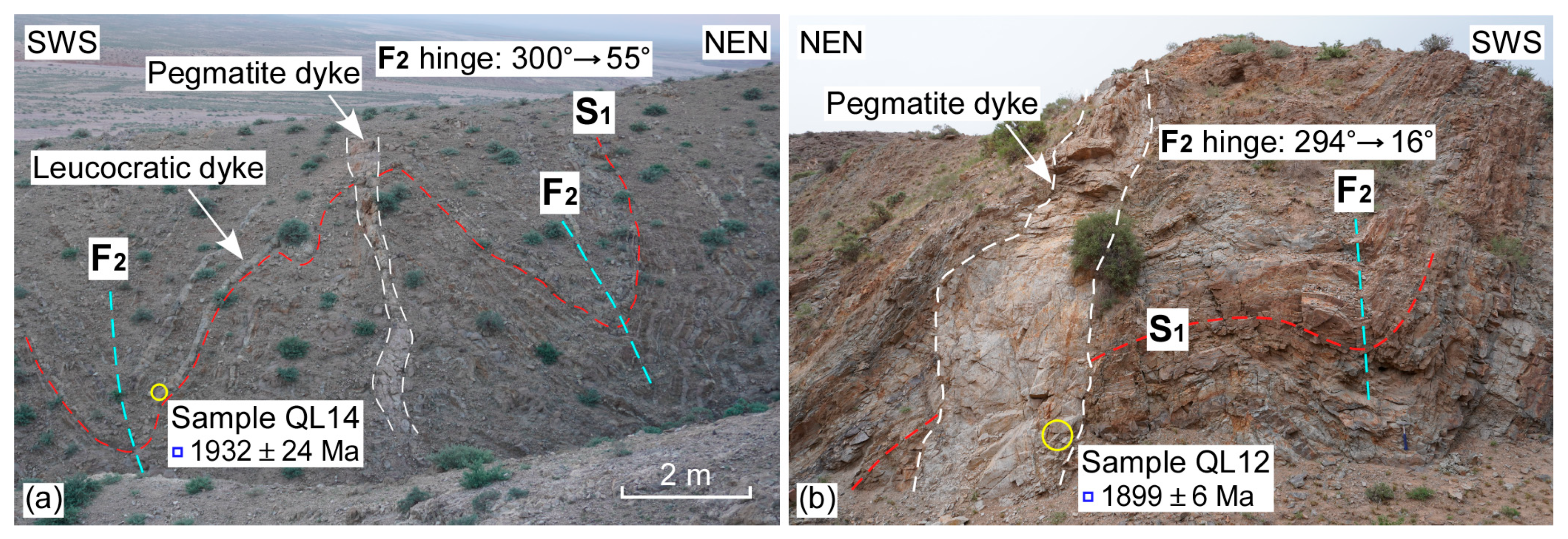



Disclaimer/Publisher’s Note: The statements, opinions and data contained in all publications are solely those of the individual author(s) and contributor(s) and not of MDPI and/or the editor(s). MDPI and/or the editor(s) disclaim responsibility for any injury to people or property resulting from any ideas, methods, instructions or products referred to in the content. |
© 2023 by the authors. Licensee MDPI, Basel, Switzerland. This article is an open access article distributed under the terms and conditions of the Creative Commons Attribution (CC BY) license (https://creativecommons.org/licenses/by/4.0/).
Share and Cite
Qiao, H.; Deng, P.; Li, J. Geochronological Constraints on the Origin of the Paleoproterozoic Qianlishan Gneiss Domes in the Khondalite Belt of the North China Craton and Their Tectonic implications. Minerals 2023, 13, 1361. https://doi.org/10.3390/min13111361
Qiao H, Deng P, Li J. Geochronological Constraints on the Origin of the Paleoproterozoic Qianlishan Gneiss Domes in the Khondalite Belt of the North China Craton and Their Tectonic implications. Minerals. 2023; 13(11):1361. https://doi.org/10.3390/min13111361
Chicago/Turabian StyleQiao, Hengzhong, Peipei Deng, and Jiawei Li. 2023. "Geochronological Constraints on the Origin of the Paleoproterozoic Qianlishan Gneiss Domes in the Khondalite Belt of the North China Craton and Their Tectonic implications" Minerals 13, no. 11: 1361. https://doi.org/10.3390/min13111361
APA StyleQiao, H., Deng, P., & Li, J. (2023). Geochronological Constraints on the Origin of the Paleoproterozoic Qianlishan Gneiss Domes in the Khondalite Belt of the North China Craton and Their Tectonic implications. Minerals, 13(11), 1361. https://doi.org/10.3390/min13111361





